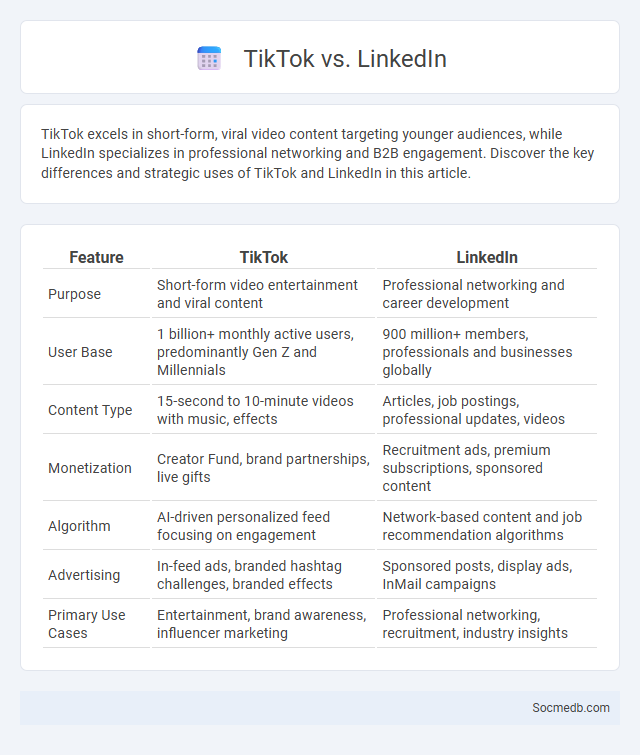
Photo illustration: TikTok vs LinkedIn
TikTok excels in short-form, viral video content targeting younger audiences, while LinkedIn specializes in professional networking and B2B engagement. Discover the key differences and strategic uses of TikTok and LinkedIn in this article.
Table of Comparison
| Feature | TikTok | |
|---|---|---|
| Purpose | Short-form video entertainment and viral content | Professional networking and career development |
| User Base | 1 billion+ monthly active users, predominantly Gen Z and Millennials | 900 million+ members, professionals and businesses globally |
| Content Type | 15-second to 10-minute videos with music, effects | Articles, job postings, professional updates, videos |
| Monetization | Creator Fund, brand partnerships, live gifts | Recruitment ads, premium subscriptions, sponsored content |
| Algorithm | AI-driven personalized feed focusing on engagement | Network-based content and job recommendation algorithms |
| Advertising | In-feed ads, branded hashtag challenges, branded effects | Sponsored posts, display ads, InMail campaigns |
| Primary Use Cases | Entertainment, brand awareness, influencer marketing | Professional networking, recruitment, industry insights |
Introduction to TikTok, LinkedIn, and Cross-Platform Promotion
TikTok revolutionizes social media with short, engaging videos that capture trends and creativity quickly, making it ideal for reaching younger audiences. LinkedIn serves as a professional networking hub, enabling you to connect with industry leaders, showcase your expertise, and advance your career goals. Mastering cross-platform promotion boosts your brand visibility by strategically sharing tailored content across TikTok, LinkedIn, and other channels to maximize engagement and reach.
Audience Demographics: TikTok vs LinkedIn
TikTok attracts a predominantly Gen Z audience, with over 60% of users aged between 16 and 24, making it ideal for brands targeting younger demographics. LinkedIn's user base skews older and more professional, with more than 61% aged 30-49 and a strong concentration of business decision-makers and industry experts. Understanding these distinct audience demographics helps marketers tailor content strategies for maximum engagement on each platform.
Content Styles and Formats Compared
Social media content styles range from short-form videos on platforms like TikTok and Instagram Reels to long-form articles and posts on LinkedIn and Facebook, each tailored to specific audience engagement patterns. Visual formats such as images, GIFs, and infographics dominate Instagram and Pinterest due to their high shareability and instant appeal. Interactive content including polls, stories, and live streams enhances user participation and retention across Facebook, Twitter, and TikTok.
Engagement Metrics: Where Do Brands Win?
Brands win in social media by leveraging key engagement metrics such as likes, shares, comments, and click-through rates to gauge audience interaction and content relevance. High engagement metrics directly correlate with increased brand visibility, customer loyalty, and conversion rates, showcasing effective content strategies. Measuring these metrics on platforms like Instagram, Facebook, and TikTok enables brands to tailor campaigns for maximum impact and sustained growth.
Algorithm Differences and Their Impact
Social media platforms utilize distinct algorithms tailored to user behavior, content type, and engagement metrics, influencing how information is prioritized and displayed. For example, Facebook's EdgeRank algorithm emphasizes friend interactions and content relevance, while TikTok's For You page leverages machine learning to personalize video recommendations based on user activity and preferences. These algorithm differences directly impact content visibility, user engagement rates, and overall platform experience, shaping both individual user behavior and business marketing strategies.
Building Brand Authority: LinkedIn vs TikTok
Building brand authority on LinkedIn leverages professional networking and thought leadership content, enabling you to establish credibility with industry experts and decision-makers. TikTok offers dynamic, short-form videos that capture mass engagement and showcase brand personality, though it may require consistent creativity to maintain authority. Your choice depends on targeted audience demographics and the desired tone of your brand presence.
Effective Strategies for Cross-Platform Promotion
Maximizing cross-platform promotion requires tailoring content to fit the unique formats and audiences of each social media channel, such as using Instagram Stories for visual engagement and LinkedIn articles for professional insights. You can boost your brand's visibility and drive targeted traffic by synchronizing posting schedules and leveraging platform-specific hashtags and analytics tools. Consistent messaging combined with strategic adaptation ensures your campaigns resonate effectively across Facebook, Twitter, TikTok, and beyond.
Measuring Campaign Performance Across Platforms
Measuring campaign performance across social media platforms involves analyzing key metrics such as engagement rates, click-through rates, and conversion rates specific to each channel. You can leverage tools like Google Analytics, Facebook Insights, and Twitter Analytics to track user behavior and attribute success accurately. This data-driven approach ensures your marketing strategies are optimized for maximum reach and ROI.
Best Practices for Integrating TikTok and LinkedIn Marketing
Effective integration of TikTok and LinkedIn marketing leverages TikTok's engaging short-form video content to capture attention while utilizing LinkedIn's professional network to foster B2B relationships and thought leadership. You should tailor content to reflect platform-specific audiences, focusing on creative, trend-driven videos for TikTok and insightful, industry-relevant posts for LinkedIn to maximize reach and engagement. Consistent branding and cross-promotion between channels boost visibility and reinforce your marketing message across diverse demographics.
Future Trends in Social Media Cross-Promotion
Future trends in social media cross-promotion emphasize increased integration of AI-driven personalization and seamless multi-platform content sharing. Brands leverage real-time data analytics to optimize engagement across networks like Instagram, TikTok, and LinkedIn, enhancing audience targeting and ROI. Emerging technologies such as augmented reality and interactive content further accelerate cross-promotion effectiveness, creating immersive user experiences.
 socmedb.com
socmedb.com